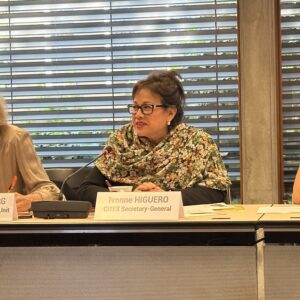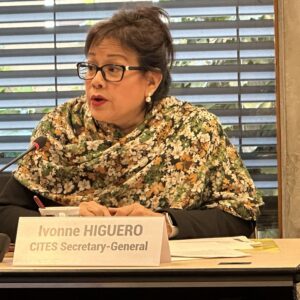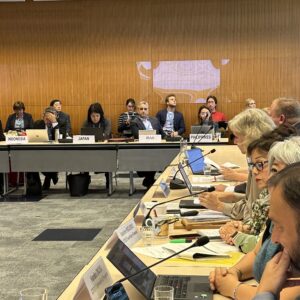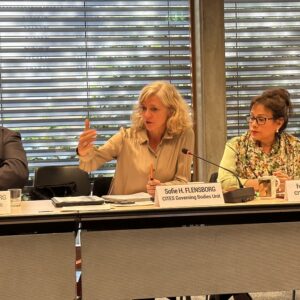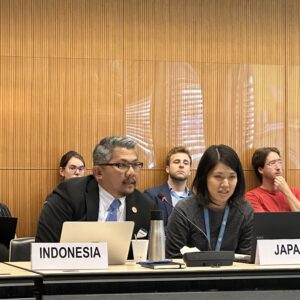Event Conference
Briefing on the 77th meeting of the CITES Standing Committee

17 Oct 2023
10:00–12:00
Venue: International Environment House II
Organization: Convention on International Trade in Endangered Species of Wild Fauna and Flora, Geneva Environment Network
This briefing focused on the preparations of the upcoming 77th meeting of the Standing Committee of the Convention on International Trade in Endangered Species of Wild Fauna and Flora (CITES SC77), to be held in Geneva, from 6 to 10 November 2023.
About this Event
The upcoming meeting of the CITES Standing Committee will bring together Members of the Committee and other Parties to the Convention as well as observer organizations to review strategic, policy and species-specific matters affecting the implementation of the Convention. This will be the first meeting after the 19th meeting of the Conference of the Parties to CITES (CoP19), held in Panama in November 2022 and the adoption of the Kunming-Montreal Global Biodiversity Framework in December 2022.
Amongst many others matters that will require careful consideration, the CITES Standing Committee will discuss the following issues, some of which were further explained at the briefing:
- Compliance matters concerning a number of Parties and species;
- Emerging operational matters – how to ensure that work under CITES progresses even under exceptional circumstances, such as a pandemic?
- What is the role of CITES in reducing the risks of a new pandemic, if any?
- How is CITES contributing to the implementation of the Kunming-Montreal Global Biodiversity Framework?
- How to better engage indigenous peoples, local communities, women and youth in CITES processes at national and international levels?
- Matters related to conservation, sustainable and traceable trade and illegal trade in a number of species, including marine species such as sharks and rays, marine turtles, totoaba; other fauna such as saiga antelopes, Tibetan antelopes, jaguars, rhinoceros, great apes, as well as timber tree species;
- Issues related to certain facilities keeping big cats and other matters related to illegal trade in big cats?
- Various elephant-related issues, including the possible recognition of two species of African elephant in the context of CITES;
- And a wide range of issues related to the regulation of trade.
Speakers
By order of intervention.

Ivonne HIGUERO
Secretary-General, CITES Secretariat

Sofie H. FLENSBORG
Chief, Governing Bodies Unit, CITES Secretariat

Haruko OKUSU
Chief, Outreach and Projects Unit, CITES Secretariat
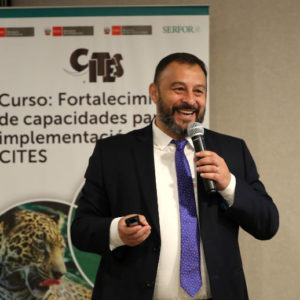
Juan Carlos VASQUEZ
Chief, Legal Unit, CITES Secretariat

Ben Van RENSBURG
Chief, Enforcement Unit, CITES Secretariat

Karen GAYNOR
Scientific Support Officer, Science Unit, CITES Secretariat
Summary
Ivonne HIGUERO | Secretary-General, CITES Secretariat
- Since the Nineteenth Conference of the Parties (COP19) to the CITES Convention took place in November 2023 in Panama City, the CITES Secretariat has been busy implementing its program of work. This includes visits to countries and to parties to be able to hold the technical trainings both online and in country to further progress the program of work.
- The upcoming 77th Standing Committee (SC77) – to take place in Geneva from 6 to 10 November 2023 – will tackle a full agenda. There will be 77 items to be addressed during the meeting.
- For parties to be fully prepared for the meeting, it is important for them to review these.
- As of 17 October 2023, 582 participants have registered from 84 parties, with 363 people coming from 84 parties of the Convention and 219 persons coming from 100 Observer organizations.
- After a period of standby due to the COVID-19 pandemic, work is fast pacing up again. Since COP19, working groups of the standing committee have been meeting the animals and plants committee; with a lot of work done intersessionally.
- Among issues to be addressed, there is identifying the role of CITES in reducing the risk of zoonotic diseases; and cooperation with other multilateral environmental agreements and other organizations vis-à-vis the adoption of the Global Biodiversity Framework by the Convention on Biological Diversity CBD in December 2022.
- Some of the ways in which CITES assists parties in the effective implementation of the GBF that will be discussed at the meeting include the compliance assistance program and the continuation of the CITES tree species program, which has been made possible by funding of the European Union.
- A large number of timber species have been added to CITES listings. These are precious woods highly employed and provide many jobs across the world; thus countries need assistance to be able to ensure timber trade in these species is sustainable and legal.
- The standing committee will discuss the gender action plan for the first time after 50 years. As CITES celebrates this year its 50th anniversary it will now have a gender action plan.
- In terms of major groups, a youth global network will be launched, while continue cultivating the important engagement of indigenous people and local communities.
- During SC77 working group meetings that took place intersessionally will report on their work.
- Subjects under science will include the review of significant trade captive breeding: with a large number of species country combinations that are right now under review of significant trade.
- Around twelve compliance cases will be discussed in addition to the work that has been going on under Totoaba and Vaquita.
- The next COP that will take place in 2025 still does not have a host, countries are invited to send their offers to ensure the organization can be started in due time.
Sofie H. FLENSBORG | Chief, Governing Bodies Unit, CITES Secretariat

- The agenda of the meeting is available on CITES website, in addition to the annotated agenda summarizing agenda items, including the recommendations from each of the documents.
- The number of documents is very large as there is more than one document per each of the 77 agenda items.
- Registration is highly recommended also to holders of UN badges to allow the Secretariat to have an overview of participants.
- Parties can still register preferably before the end of October while the deadline for NGOs to register was 7 October. Media accreditation must be done through an online form and submitted as soon as possible.
- Parties – particularly those who are members of the Standing Committee – must submit credentials through a scanned copy sent by email preferably before the end of October. Alternatively, credentials can also be handed over on-site.
- All plenary sessions will be live-streamed in English, French and Spanish on CITES YouTube channel.

- Agenda item 16 on Strategic Vision (SC77 Doc. 16) will deal with taking into consideration and contributing to the implementation of the Kunming-Montreal Global Biodiversity Framework (GBF), adopted in December 2022, just after CITES COP19.
- The Secretariat has prepared a mapping linking our strategic Vision 2021-2030 with the sustainable development goals and the goals in the GBF. We then propose some minor amendments to one of our resolutions referring to the GBF and propose some changes to the reporting framework. This allows using indicators from the GBF and the SDGs when parties report on implementation.
- The mapping allows Parties to use the data they have collected under one of the frameworks and use it for the other. Such modification is clearly spelled out in the new implementation report guidelines, to be discussed at the SC77 meeting.
- Agenda Item 16 will also feature the Secretariat Report on possible indicators for objective 1.4 of the strategic vision “The appendices correctly reflect the conservation status and needs of a species”. The standing committee will be invited to consider this new indicator as well as the other objectives and indicators already agreed upon by COP19.
- Mapping and amendment to the resolution on cooperation of CITES with other biodiversity-related conventions to ensure that there is a link to the GBF.
Cooperation
- Agenda item 18 (SC77 Doc. 18) deals with the development of a partnership strategy for CITES as it sits strategically at the intersection of environment, biodiversity conservation and trade.
- CITES collaborates with various partners, including UN organizations such as UNODC and UNEP, international and non-governmental organizations, and private sector.
- COP19 decided we must be more strategic about how we select partners, enter partnerships, and identify any gaps where more partnerships are required.
- The Secretariat will report on progress on developing this strategy and invite the SC to take note of this and provide options for this.
- The Secretariat is reporting on some opportunities for highlighting the achievement of CITES and advancing on synergies. At United Nations Environment Assembly (UNEA) in February 2023, there will be a formal agenda related to MEAs for the first time. The Secretariat will encourage parties to coordinate their participation and make sure that UNEP delegates are fully briefed on CITES for this agenda item in February next year.
- The Bern III Conference on Cooperation among the Biodiversity-related Conventions for the implementation of the Kunming-Montreal GBF will take place from 22 to 24 January 2023. CITES has been invited to nominate five participants from its standing committee to take part in the conference to further discuss synergies and how MEAs can contribute to the implementation of the GBF in a coordinated manner.
Emerging Operational Matters
- The Secretariat has come up with two guiding principles for the best course of action in the case of forced interruptions of work by exceptional circumstances: 1) in-person meeting as the default options for all cites permanent committees and 2) online or hybrid options would be considered only when quorum might be reached.
- Since COP18 in Geneva in 2019, the Secretariat has been taking steps to expand official languages from English, French, and Spanish to the other three UN official languages. Fundings to translate about 100 resolutions are being collected currently and Switzerland has generously offered funding for this.
- The translations of all our resolutions in the six languages will be ready before the next COP, and hopefully, funding will also allow us to have interpretation in the six languages at our next meeting of the conference of the parties. More information can be found on Agenda item 12.
Haruko OKUSU | Chief, Outreach and Projects Unit, CITES Secretariat

- The standing committee meeting often has several agenda items related to elephants across various areas of science policy, compliance, and law enforcement issues.
- Agenda Item 1 is one of our regular reports on the implementation of resolution Conf 10.10 on trade in elephant specimens and it consists of five sections covering coaching and seizure trend analysis, policies, implementation of priority recommendations from the review of the ETIS program, and conservation status of elephants, a report from UNEP on the African elephant action plan and the African elephant fund, and closure of domestic ivory markets.
- The report underlines that the poaching seems to continue, showing a downward trend in most sub-regions, whilst experiencing some challenges in data collection.
- Data also seems to suggest increasing evidence of elephant deaths due to droughts and human-elephant conflict in sub-regions. This requires further and closer observation in the future.
- The agenda item on the MIKE-ETIS (SC77 Doc. 63.2) sustainability, as highlighted in the document, stresses the financial and operational challenges that MIKE-ETIS programs are facing now and the need to refocus its priorities review its program and revitalize both programs in the near future.
- Agenda item 55 is a document that has been submitted by Botswana and a dialogue meeting for African elephant range States. Botswana requests the standing committee to call for an official dialogue meeting in the implementation of decision 167 and also to review the draft terms of reference accordingly. Botswana has also offered to host the meeting and expresses interest to discuss other issues of African elephant conservation, on the occasion of the dialogue meeting for the African elephant reinstates.
- Agenda item 74 on the African elephant taxonomy and nomenclature deals with the recent discussion on the distinction of African elephants into two separate species and the potential impact of recognizing this distinction in the implementation of the convention.

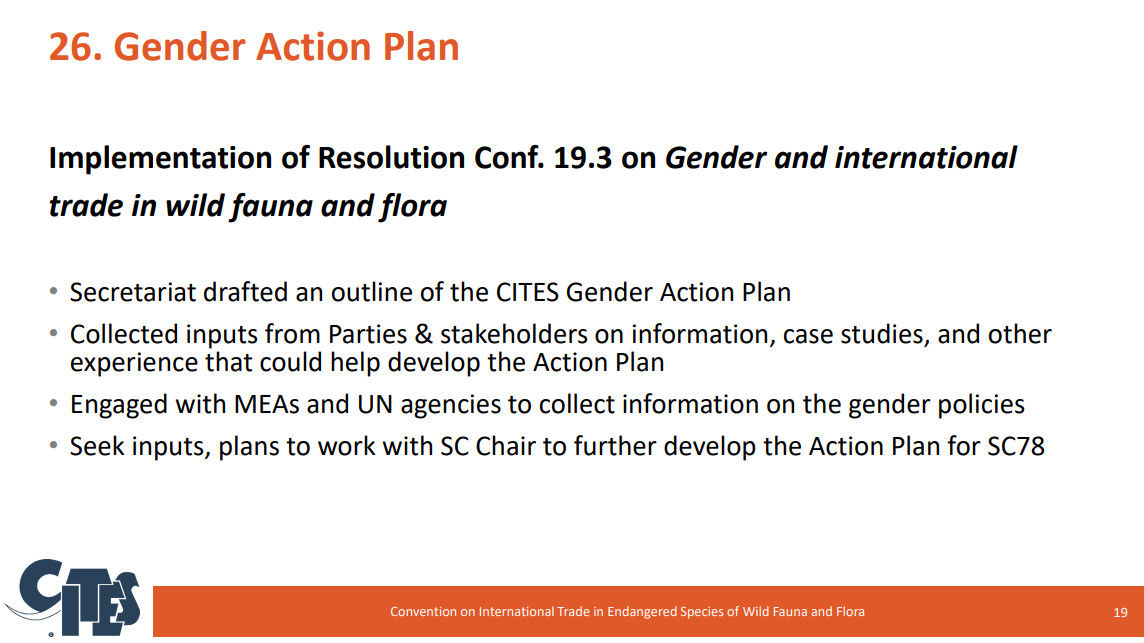
- CITES parties have started to turn their focus on stakeholder engagement in recent years. Two agenda items that are introducing some new developments in this area include a gender action plan (Agenda Item 26) and CITES Global Youth Network (Agenda Item 27).
- Singapore will host the first CITES youth leadership program and the first Global Youth Summit in Singapore in March 2025 and calls upon parties to support its efforts.
Juan Carlos VASQUEZ | Chief, Legal Unit, CITES Secretariat
- The Legal Unit will address compliance matters, for the understanding of which Article 13 of the Convention is essential.
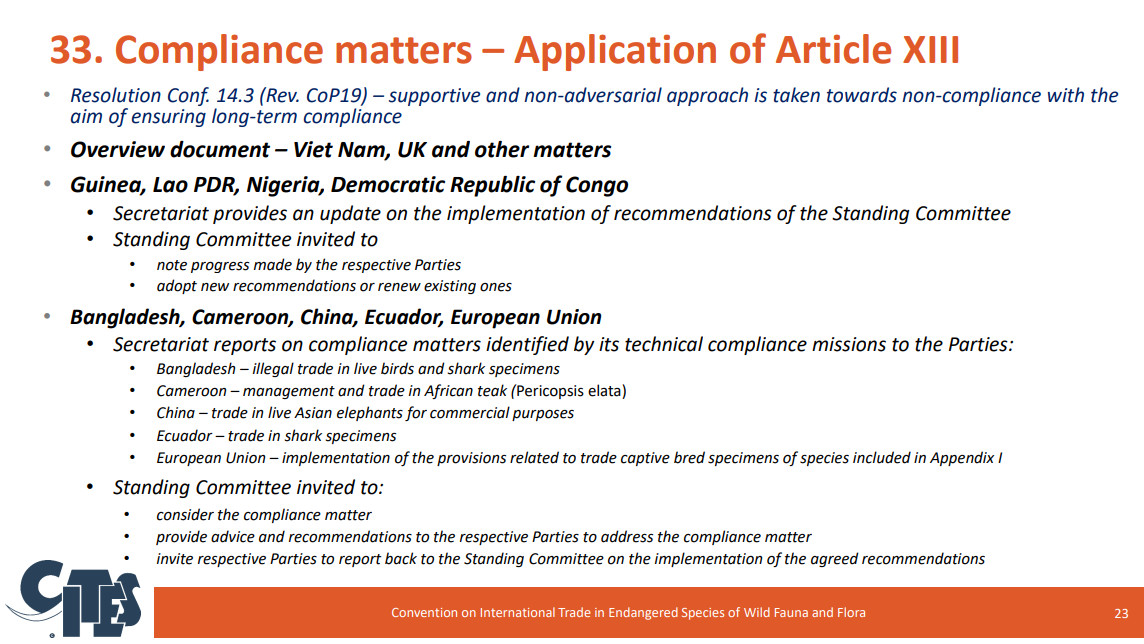
- Annex 1 of resolution 18.2 contains the terms of reference for the Standing Committee. Among functions, the first one is undertaking tasks directed by the COP, including tasks related to the handling of general and specific compliance matters.
- Resolution 18.2 also details the composition of the standing committee: 16 members from 6 geographical regions plus the depositary government and the previous host country Panama, 18 members in total, 16 voting and in case of the depositary government will break that.
Compliance Cases
- SC77 will address 12 cases. Discussions will tackle national laws while reporting a mega timber case concerning 16 States from West Africa; trade-in Pterocarpus erinaceous tree; and jaguars and other legal matters such as harvesting and trading from the areas beyond the national jurisdiction of trade in the high seas; the verification of legality. There will also be discussions on annotations and comments on the amendments to the rule of procedures for the COP.
- Items under section 33 of the SC77 Agenda (33. Compliance matters) address all these items, for which resolution 14.3 – containing all the principles and procedures for handling compliance matters in CITES – can be useful.
- The approach adopted in these cases is supportive and non-adversarial. The idea is to assist and help parties facing compliance, and difficulties to meet those commitments.
- CITES has prepared a general document on compliance that offers an overview of compliance and is reporting on the cases concerning Vietnam on timber and the UK on breeding captivity.
- Species listed in Appendix 1, which is the appendix that contains more or less 900 species of mainly animals and some plants and that is the most restrictive appendix.
- Other cases brought before the SC include Lao PDR, Nigeria, and the Democratic Republic of Congo. We would like to see some of these cases closed, but it will not be possible to resolve them during this session of the Committee.
- New cases identified last year concerning Bangladesh mainly for trading birds and timber species – some of which were listed in Panama and some rules entered into force in February this year- Other cases concern trade in Asian elephants from Lao PDR, China, and Ecuador on sharks and links with Peru.
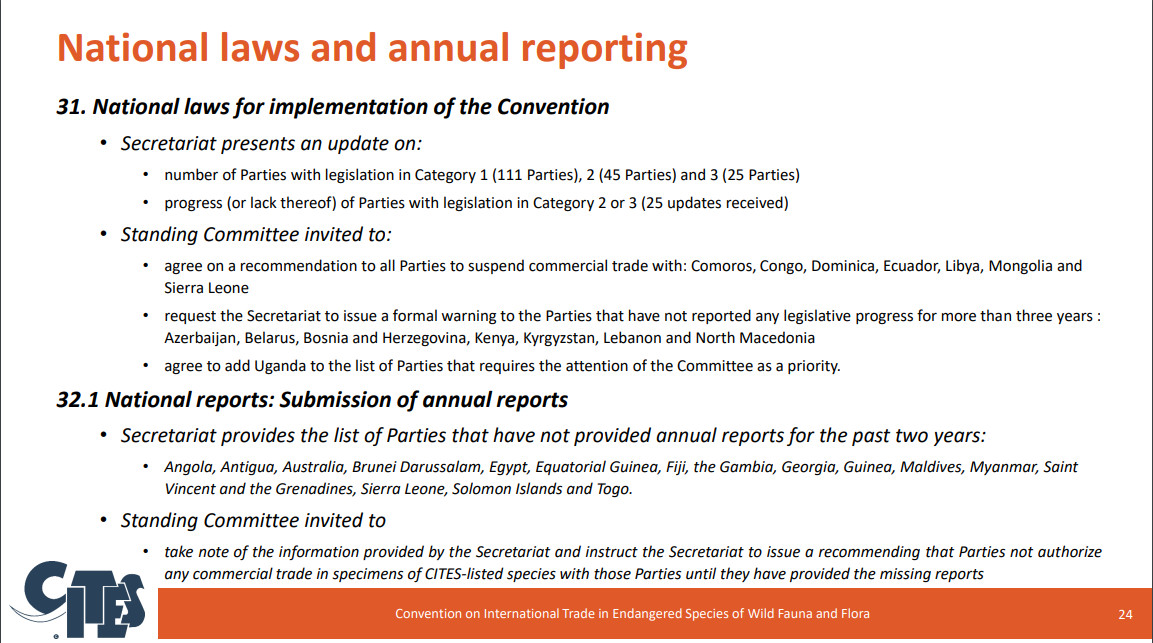
- CITES assesses the legislation of all the 184 parties according to four criteria and ranks legislation in three qualitative categories.
- Parties have been progressing and the majority currently rank in category one, but there still is room for improvement.
- SC77 will also bring up recommendations concerning Comoros, Congo, the Dominican Republic, Ecuador, Libya, Mongolia, and Sierra Leone. We are also suggesting formal warnings for Azerbaijan, Belarus, Bosnia Herzegovina, Kenya, Kyrgistan, Lebanon, and North Macedonia.
- In national reports, parties also must submit an annual report detailing all the trade they have authorized during the past year. The deadline for them to submit is October of the following year.
- If a party does not submit a report for three consecutive years, there is automatic trade suspension. The status of submissions will be reported to SC77.
- Countries that are delayed in their reports include Angola, Antigua, Australia, Egypt, Equatorial Guinea, Fiji, The Gambia, Georgia, Guinea, Maldives, Myanmar, Saint Vincent and the Grenadines, Sierra Leone, Solomon Islands and Togo. If they do not submit their annual reports within 60 days after the Standing Committee, they will be suspended for commercial trade.

- The Secretariat is bringing a mega compliance case on 16 countries that are range states to a species called Pterocarpus erinaceous.
- The related document (SC77 Doc. 33.2.2) will see the status of all the different programs made by CITES. It verifies legality and sustainability, respectively through legal acquisition findings and non-determent findings. The 16 countries will be evaluated against those.
- We are bringing jaguars this time to the table, with several recommendations for a monitoring system on a platform for a continental action plan and a platform of cooperation between the range states there is a working group on jaguars, chaired by Brazil, the newest member of the Standing Committee and who has the mandate to assess the merits of adopting a resolution on jaguars in CITES.
- The discussion will be around the potential need for resolutions for each species or whether a cluster approach will be better.

- While we list more and more species, we need to define clearly what we mean by harvesting from the sea. The document that will be discussed at SC77 discusses the importance of standardizing this practice.
- CITES collaborates with FAO on building capacity and on the verification of legality, especially to develop tools through the CITES-Lex project, aimed at supporting countries in making legal acquisition findings.
- There is a proposal to create an informal review mechanism for existing and proposed annotations and we have a consultant that is working on that.
- Concerning the information system for trading trees, we wish to understand if we should go more in-depth in terms of annotations as these currently refer mainly to raw material.
- In terms of socio-economics, the working group on livelihoods is chaired by Peru, which recently hosted a meeting in Cusco with the participation of indigenous communities from several countries including New Zealand. The conclusions of the two working groups, their progress and recommendations will be presented to the standing committee together with a document we also prepared on lessons learned.
Amendment of the rules of procedure for the COP
- The COP updates the list of species and as a lot of voting occurs in CITES, there are discussions to amend rules on how to cluster proposals.
- A working group chaired by the United States is reporting on the progress made on this issue.
Ben Van RENSBURG | Chief, Enforcement Unit, CITES Secretariat

- The document on enforcement matters that was prepared for the meeting is number 39.1. This document addresses a wide variety of issues:
- Corruption, which continues to pose a challenge to addressing wildlife crime. Nevertheless, the document appreciates how parties seem to increasingly take strict action where corrupt practices are detected;
- Issues regarding the cases of Cambodia and the Democratic Republic of Congo;
- Illicit financial flows from wildlife crime. There continues to be room for improvement regarding the integration of financial crime investigations. In wildlife crime investigations this is important to ensure criminals do not benefit from the proceeds of their crimes and to facilitate the shift in focus from the lowest level of the trafficking chain the poachers to those at the top level, managing and organizing the trafficking at international level;
- Activities conducted since COP19 to support work related to addressing illicit financial flows from wildlife crime;
- Information on the CITES illegal trade database. As of August 2023, over 115,000 seizure records were reported by our parties in the CITES illegal trade database. The value of this database is increasingly evident as more and more data is recorded and used, informing for instance the Third Wildlife Crime report and other relevant documents informing SC77 and beyond. The CITES illegal trade database dissemination platform is also being finalized, which will make data in the database directly accessible to all parties and become a powerful tool for them can analyze and use what happens and to inform the law enforcement responses. CITES illegal trade database is currently subject to external funding and we deem it highly important that sustainable funding to maintain it is secured to maintain this database;
- Information on the directory of laboratories that conduct wildlife forensic testing. Since the Forest Research Institute of Malaysia has been included in the directory, there currently are 15 library laboratories in the directory. These laboratories meet the highest standards, and we encourage our parties to draw upon their services when needed to make sure we also mobilize forensic technology against wildlife crime.
- The standing committee will consider recommendations regarding addressing illicit financial flows, the directory of laboratories and the CITES illegal trade database.
Secretariat reports on Totoaba:
- Relevant documents on this issue are SC77 Doc. 33.13.1 and SC77 Doc. 33.13.2
- While an update on the development and implementation of a compliance action plan by Mexico, milestones have not yet been achieved.
- Mexico also provided an update on the operationalization of the Trilateral Contact Group (China, Mexico and United States of America) on Law Enforcement.
- The Standing Committee:
- welcomes the rapid progress made by Mexico with the implementation of its compliance action plan and requests Mexico to consider the Secretariat’s observations on the implementation of the action plan and prepare another report for the next meeting;
- It also requests China, Mexico, and the USA to report on the operationalization and activities of the Trilateral Contact Group to the next meeting of the Committee.
- Requests the Secretariat to conduct missions to China and the USA to get a better understanding of measures and activities being implemented in accordance with the provisions of paragraphs A to C of Decision 18.292 (Rev. COP19)
- Requests the Secretariat to work with INTERPOL and UNODC to convene a Wildlife Inter-Regional Enforcement (WIRE) meeting and a Regional Investigative and Analytical Case Meeting (RIACM) on Totoaba;
The Secretariat reports on the outcome of the meeting of the Big Cat Task Force, held in Entebbe, Uganda, in April 2023, including the outcome document recommending measures in the following areas:
- strengthening effective implementation and enforcement of the Convention with regard to illegal trade in big cat specimens;
- strengthening regulation of facilities breeding big cats in captivity to prevent and detect any illegal trade from such facilities and deploy strengthened enforcement measures;
- reducing demand to combat illegal trade in big cat specimens;
- identification of big cat specimens in trade; and
- strengthening regional and international collaboration to address illegal trade in specimens of big cats.
- The Standing Committee is invited to: consider the proposal of a resolution on illegal trade in big cats; encourage all Parties affected by illegal trade in specimens of big cat species to make every effort to implement the strategies, measures, and activities outlined in the CITES Big Cats Task Force outcome document, as a matter of priority.
Species-specific enforcement matters
- The Secretariat was requested to undertake missions to identify parties in whose territories some facilities may be of concern keeping Asian big cats in captivity, to gain a better understanding of the operations and activities undertaken by these facilities.
- The Secretariat report (SC77 Doc. 41.1) on the status of Asian big cats in the wild, their conservation, and trade controls in place in Parties
- The Standing Committee is invited to:
- note the information provided by the Parties;
- encourage all Parties affected by illegal trade in Asian big cat species to include seizure data related to these species in their annual illegal trade reports and submit their reports promptly;
- Due to a lack of specific information, invite Parties and range States to report information on conservation measures undertaken; poaching incidents detected; and seizure data involving the leopard (Panthera pardus)
- The Secretariat reports on findings and conclusions from missions undertaken to: the Czech Republic, Lao PDR, South Africa, Thailand, and Viet Nam
- The Standing Committee is invited to consider recommendations directed to Parties in whose territories facilities are keeping Asian big cats in captivity, which inter alia relates to:
- strengthening compliance monitoring and enforcement of legislative provisions relating to facilities keeping tigers in captivity
- taking a more methodical proposed approach regarding facilities that breed large numbers of tigers and facilities housing large numbers of tigers
- to enhance their efforts in demand reduction activities related to illegal trade in Asian big cats
- Specific recommendations were directed to the Parties visited during the missions.
- Encouraging governments, intergovernmental organizations, international aid agencies, and nongovernmental organizations to provide funds and other assistance to Parties with facilities that breed large numbers of tigers and those housing large numbers of tigers, to support the implementation of the methodical approach proposed.
The Secretariat inter alia:
- Reports on the implementation of Resolution Conf. 9.14 (Rev. CoP19) on Conservation of and trade in African and Asian rhinoceroses and Decisions 19.117, 19.118, and 19.119 regarding measures to address the illegal killing of rhinoceros and trafficking of rhinoceros’ horn
- The document focuses on Botswana, China [including the Hong Kong Special Administrative Region (SAR) of China], Malaysia, Mozambique, Qatar, South Africa, the United Arab Emirates and Viet Nam, as the Parties most affected by the illegal trade in rhinoceros horns.
- The Secretariat also addresses emerging issues of concern related to Angola and Namibia
- Further, the Chitwan Declaration for Asian Rhinos Conservation 2023 agreed upon by the five Asian rhinoceros range states and the directory of illegal Trade in rhinoceros horn focal points are addressed in the document.
The Standing Committee is invited to:
- welcome the Chitwan Declaration for Asian Rhinos Conservation 2023 agreed by the five Asian rhinoceros’ range countries.
- consider recommendations specific to the Parties mentioned.
- Request parties included in the Directory of illegal
Agenda Item 39.2 International Consortium on Combatting Wildlife Crime (ICCWC)

- ICCWC is the collaborative effort of five intergovernmental organizations – the CITES Secretariat, INTERPOL, the United Nations Office on Drugs and Crime (UNODC), the World Bank, and the World Customs Organization – working to bring coordinated support to national wildlife law enforcement agencies and the sub-regional and regional enforcement networks that act in defense of natural resources.
- The consortium continued to play a critical role in engaging and working with parties globally to combat wildlife crime and in the document the Secretariat reports on the activities conducted under the hospices and the document also highlights Vision 2030, which will provide a road map for the activities over the next decade in terms of recommendations, the standing committee will consider recommendations that relate to the efforts of parties to combat wildlife crime.
Karen GAYNOR | Scientific Support Officer, Science Unit, CITES Secretariat
- The Strategic importance of CITES in the conservation of forests and sustainable forest management will be discussed under Agenda Item 21. This builds on the collective knowledge resources mechanisms and networks of the existing global governance framework on forests.
- The Secretariat reports on:
- progress made in preparing a CITES and forest compendium. This catalogs all resolutions and decisions that may be relevant for any new initiative on CITES and forests with a focus on tree species;
- preparations of a multidisciplinary study on CITES and Forest, and this includes a draft term of reference that has been developed with the Plants Committee secretary.
- scope of new initiatives as agreed by the plants committee that will initially focus on CITES list of tree species and eventually e could include all forest species of fauna and flora; and
- efforts to enhance and raise awareness on CITES contributions to global forest relevant mandates and forest policies and initiatives, including the 18th session of the United Forum on forests some bilateral engagements with the GGF and a high-level meeting with FAO on CITES and Forest.
- At SC77, the standing committee is invited to consider the progress made and to explore options aligned with the CITES Strategic Vision to enhance the implementation of CITES with respect to CITES-listed forest species, its contribution to global forest-relevant mandates and to raise awareness of the importance of investing in the conservation and sustainable management and legal trade of CITES-listed for Forest species.
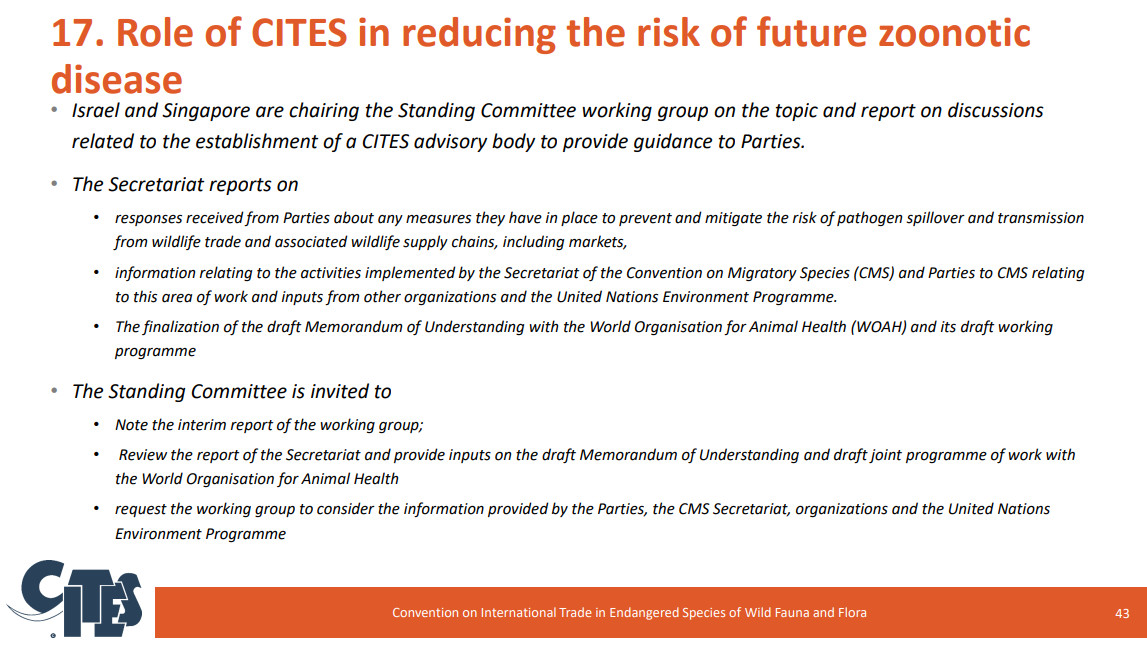
- The first is a report from the intersessional working group of the standing committee (SC77 Doc. 17.1), established just after COP-19. This working group is co-chaired by Israel and Singapore. The working group reports that most of the members did not see it as a need for this advisory body at this stage, but these discussions are still ongoing.
- The second document (SC77 Doc. 17.2) is from the Secretariat and reports on responses received from parties to a notification to the parties about any measures that they have in place to prevent and mitigate the risk of pathogen spillover and transmission from Wildlife Trade and Associated Wildlife Supply chains, including markets.
- It also includes inputs from other organizations the draft memorandum of understanding with the World Organization for Animal Health (WOAH) and the draft working program.

- The overview also provides details of CITES new database on tracking and management system, which will be a great resource for parties who find themselves in the review process.
- They will be able to keep track of where they are, what recommendations they face, what the deadlines are and then it will help us all to correspond directly with the countries and the Secretariat to correspond directly with the countries.
- The two documents that will need decisions from the standing committee are documents on the cases concerning animals first and then plants. Second, it is a documents on the implementation of the recommendations from the animals committee (SC77 Doc. 35.2).
- The plans committee will provide an update when new information is available noting that the last time these cases were discussed a was at SC75, so where we have new information provided from the range States or where some deadlines have expired.
- These are the cases that are being considered at this meeting,19 of which concern fauna.
- Countries in question are Indonesia, Guyana, Suriname, Grenada Equatorial, Guinea, Democratic Republic of Cameroon, Democratic Republic of Congo, Mali, Algeria, Morocco and Tunisia.
- In the case of flora, there are 15 cases for review and the countries in question are Nicaragua, Panama, the Democratic Republic of Congo, the Democratic Republic of Cameroon, India, and the eight countries present in Article 13.
- 48 of these 118 species country combinations are currently subject to a standing committee recommendation to suspend trade and there is one recommendation for a new trade suspension concerning Mali. All of the other recommendations have been made in consultation with the members of the animals and plants committee.
- All of the rest of them are either to be retained or removed, so you have to look at the list of the countries and the cases just to see if there are also some clarifications that your countries could provide that would assist the standing committee in its deliberations.
- The standing committee will have to decide on the necessary action and make recommendations for these 34 cases that will be considered at this meeting.

- The review of trade in animal specimens reported as produced in captivity (SC77 Doc.36). will take a similar process to the review of significant trade but looks at the trade-in appendix one and appendix two listed species, thus looking at animal species that are reported. A large portion of international trade now involves animals that are reported as captive bread and the convention provides for special treatment of such specimens as defined by the parties.
- So, while a non-determent finding is not needed to export captive bread specimens they must be able to demonstrate thatthe parental stock was sourced legally.
- The 74th meeting of the Standing Committee found 11 species country combinations were retained in the review process. These are the only current cases, and this document will look at the recommendations on how they have been imported into the Secretariat’s assessment in consultation with the Animals Committee and the standing committee will be invited to decide on appropriate actions and again make recommendations to the country or countries concerned.
- In this case, there are recommendations to remove eight of the combinations to retain three of the combinations.
- This guidance material has been developed in collaboration with parties and also with the animals committee, the plant committee the standing committee, and experts in the field.
- The guidance that will be developed and coming out of this workshop it will then need to be tested in the field and one thing we will be looking for parties to volunteer to test this guidance and see how it applies in the field and then provide some feedback.
- Another area that the workshop will look at is developing a feedback mechanism so that we will be able to learn from parties as they apply this guidance in the field, this will be an iterative process where we continue to learn and develop guidance from seeing how parties can apply.
Q&A
Q: What is the position of the contracting party on who is not the member of the standing committee?
Ivonne HIGUERO: There are members of the standing committee but then we also have observer parties participating in the meeting.
Sophie FLENSBORG: The committee consist of 20 parties, 18 of which are Regional representatives and then we have the depositary government of Switzerland.
- The former and future host of the Committee are also members of the standing committee and are responsible for making the decisions.
- Members of the SC are given the priority but if time allows, the floor will be given to observers.
Juan Carlos VASQUEZ:
- Parties subject to compliance procedures and observers are more than welcome to attend.
- Observer parties play an important role during the discussion and working. NGOs are and representative of the private sector are also welcome. We are trying to bring some of the parties that are concerned by Article 13 processes.
Japan: How many delegates of a standing committee member can be seated at the venue?
Sophie FLENSBORG: Hopefully we will be able to accommodate two people to seat at the table and two people behind.
Closing
Ivonne HIGUERO
The CITES Secretariat main goal is to help parties comply with the Convention and ensure that there’s no overexploitation. CITES aims to avoid the exploitation of resources and rather foster their sustainable us for those to exist for future generations and to support economies, jobs and a healthy planet.
Highlights
Video
Live in the room with slides
Live on facebook (more difficult to follow slides)
Photo Gallery
Documents
Links
- The provisional agenda of the meeting is available on the CITES website
- Biodiversity and Geneva


